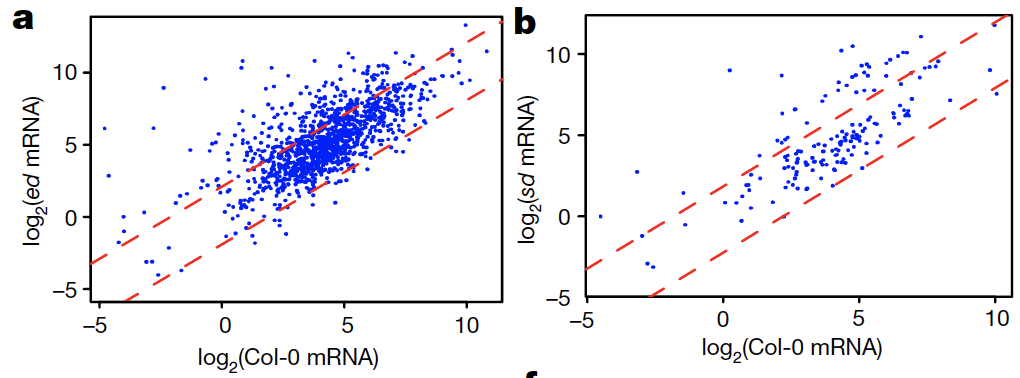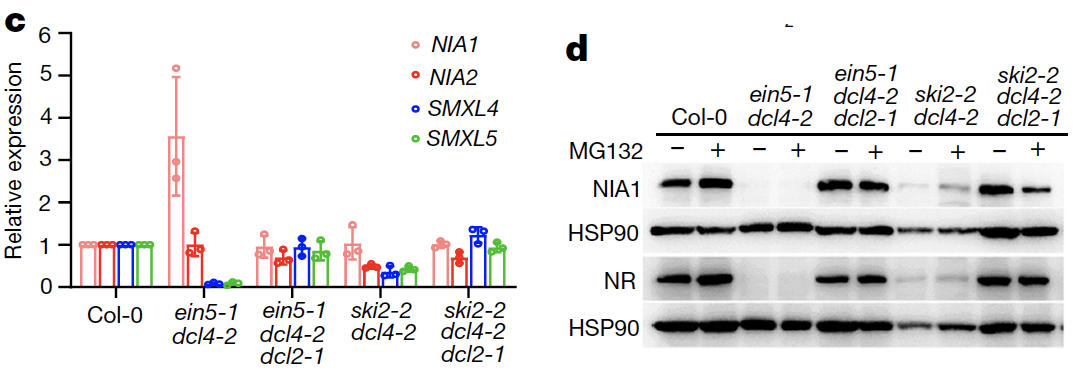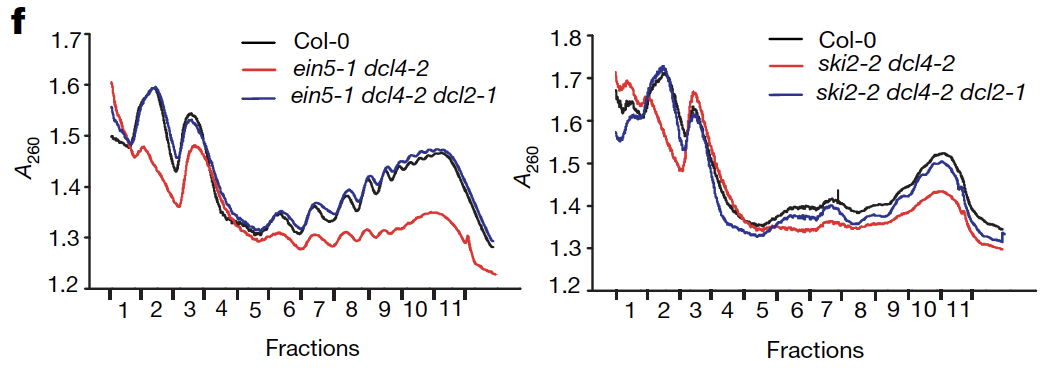博文
Nature:植物22-nt siRNA介导翻译抑制与胁迫适应
||
Plant 22-nt siRNAs mediate translational repression and stress adaptation
第一作者:Huihui Wu
第一单位:南方科技大学
通讯作者:Hongwei Guo
Abstract
背景回顾:Small interfering RNAs (siRNAs) are essential for proper development and immunity in eukaryotes. Plants produce siRNAs with lengths of 21, 22 or 24 nucleotides.
提出问题:The 21- and 24-nucleotide species mediate cleavage of messenger RNAs and DNA methylation, respectively, but the biological functions of the 22-nucleotide siRNAs remain unknown.
关键发现:Here we report the identification and characterization of a group of endogenous 22-nucleotide siRNAs that are generated by the DICER-LIKE 2 (DCL2) protein in plants.
主要结果:When cytoplasmic RNA decay and DCL4 are deficient, the resulting massive accumulation of 22-nucleotide siRNAs causes pleiotropic growth disorders, including severe dwarfism, meristem defects and pigmentation. Notably, two genes that encode nitrate reductases—NIA1 and NIA2—produce nearly half of the 22-nucleotide siRNAs. Production of 22-nucleotide siRNAs triggers the amplification of gene silencing and induces translational repression both gene specifically and globally. Moreover, these 22-nucleotide siRNAs preferentially accumulate upon environmental stress, especially those siRNAs derived from NIA1/2, which act to restrain translation, inhibit plant growth and enhance stress responses.
结论总结:Thus, our research uncovers the unique properties of 22-nucleotide siRNAs, and reveals their importance in plant adaptation to environmental stresses.
摘 要
小的干扰RNA(siRNA)对于真核生物的正确发育和免疫至关重要。植物能够产生长度分别为21nt、22nt以及24nt的siRNA。其中,21nt和24nt的siRNA分别介导信使RNA(mRNA)的剪切和DNA甲基化,但是22nt siRNA的生物学功能还不清楚。本文中,作者报道了植物中由DCL2蛋白产生的内源22nt siRNA的功能鉴定。当胞质RNA衰减和DCL4存在缺陷时,22nt siRNA大规模的积累导致多种生长紊乱,包括严重的侏儒化、分生组织缺陷以及色素沉着。值得注意的是,两个编码硝酸还原酶的基因NIA1和NIA2所产生的22nt siRNA占了所有过量积累的siRNA的一半。22nt siRNA的产生诱发了基因沉默效应的扩大,并且能够同时特异性和整体性地诱导基因的翻译抑制。此外,这些22nt siRNA在环境胁迫时会优先积累,尤其是来自于NIA1和NIA2基因的siRNA,从而通过限制基因翻译来抑制植物生长,增强植株的胁迫响应。因此,本文的研究首次揭示了植物22nt siRNA的独特特性,并且发现了其在植物适应环境胁迫的过程中发挥重要作用。
细胞内的双链RNA(double-stranded RNA, dsRNA)前体由RNA依赖性的RNA聚合酶产生,发卡microRNA(miRNA)前体会被Dicer家族蛋白剪切形成20-24nt的small RNA二聚体(sRNA duplex)。sRNA二聚体的一条链会结合到AGO蛋白上,形成一个RNA诱导沉默复合物RISC。拟南芥基因组一共包含4个Dicer-like(DCL)家族蛋白。其中,DCL1主要负责产生植物体内大部分的miRNA,作用于靶mRNA的剪切或翻译抑制。DCL3剪切dsRNA前体,形成24nt的siRNA,参与RNA指导的DNA甲基化。DCL4作用于21nt siRNA的产生,指导mRNA的剪切。而DCL2被认为参与22nt siRNA的产生。然而,22nt siRNA如何参与植物的生物学进程还不清楚。
结果1 - Massive production of 22-nt siRNAs
<为了研究植物中的siRNA功能,先上突变体。>
在前期研究中(p.s. 郭老师2015的Science大作,DOI: 10.1126/science.aaa2618),作者发现拟南芥的5’-3’和3’-5’胞质RNA衰减是由EIN5和SKI2两个蛋白介导的。这两个蛋白会通过抑制来源于转录本siRNA的积累,来避免内源性的基因沉默。而ein5 ski2突变体会异常积累大量的21nt和22nt的siRNA,从而导致内源性基因沉默效应扩大,引起植株的生长缺陷。由于,21nt的siRNA是由DCL4介导产生的,而ein5 dcl4和ski2 dcl4双突的植株有着严重缺陷(Fig. 1a,b),暗示21nt siRNA的生成被阻断了,剩下的22nt siRNA过量积累对于植物生长非常不利。相反,ein5 dcl2和ski2 dcl2双突植株的表型比较正常(Fig. 1a,b),暗示22nt siRNA产生被阻断后,植株的生长恢复正常。为了进一步验证猜想,作者进一步获得了ein5 dcl4 dcl2和ski2 dcl4 dcl2三突植株,发现这些三突植株表型恢复正常(Fig. 1a,b),说明dcl2突变能够拯救ein5 dcl4和ski2 dcl4双突的缺陷表型,即22nt siRNA的过量积累是这两个双突缺陷表型的罪魁祸首。另外,作者还发现转录后基因沉默突变rdr6同样能够拯救ein5 dcl4和ski2 dcl4双突的缺陷表型(Fig. 1a,b)。22nt siRNA的产生同样依赖于RDR6蛋白,因此进一步说明了22nt siRNA的过量积累对于植物正常生长不利。
为了进一步完善这部分的试验(还没看见确确实实的siRNA含量测定),作者利用sRNA测序,测定了这些个突变体中21nt和22nt的siRNA含量。结果发现,ein5 dcl4和ski2 dcl4双突植株中确实大量积累了22nt siRNA(Fig. 1c)。
显然,这个结果与之前有关DCL2和DCL4分别作用于22nt和21nt siRNA产生的结论一致。此外,通过sRNA测序(深挖信息,不能浪费),作者发现大部分的22nt siRNA来自于两个硝酸还原酶编码基因NIA1和NIA2(Fig. 1d-f)。
Fig.1d, e, Percentages of top-scoring 22-nt-siRNA-generating loci, ranked by 22-nt siRNA abundance in ein5-1 dcl4-2 (d) and ski2-2 dcl4-2 (e) mutants.
结果2 - 22-nt siRNAs repress mRNA translation
<既然知道了22nt siRNA的过量积累对于植物生长不利,那么接下来自然就是研究这些22nt siRNA如何发挥作用的。>
首先,上组学,结果显示之前能够产生22nt siRNA的那些个基因大多数在ein5 dcl4和ski2 dcl4双突中的表达并未下调(Fig. 2a,b)。相反,NIA1和NIA2在ein5 dcl4和ski2 dcl4双突中的表达量要么增加,要么并未发生较大的改变(Fig. 2C),暗示这些22nt siRNA并不是通过剪切mRNA发挥作用。那么,做蛋白。结果发现,在ein5 dcl4和ski2 dcl4双突中几乎检测不到NIA1和NIA2蛋白,而在野生型、ein5 dcl4 dcl2以及ski2 dcl4 dcl2三突植株可以明显检测到NIA1和NIA2蛋白(Fig. 2d),暗示ein5 dcl4和ski2 dcl4双突中NIA1和NIA2的翻译,而不是转录出了问题。此外,作者还通过多聚核糖体分析技术测定了正在翻译的mRNA丰度,结果显示ein5 dcl4双突中NIA1与多聚核糖体(在蛋白质合成过程,mRNA分子通过结合多个核糖体合成若干条蛋白质多肽链,而结合在同一条mRNA上的核糖体就称为多聚核糖体,polysome)相关的mRNA要比野生型和ein5 dcl4 dcl2三突要少(Fig. 2e)。而且,ein5 dcl4双突整体的多聚核糖体相关mRNA丰度都要较野生型低,而能被dcl2突变拯救(Fig 2f),暗示存在整体的翻译抑制。
 Fig. 2 | 22-nt siRNAs repress mRNA translation. a, b, Levels of expression of 22-nt siRNA genes in 20-day-old wide-type Col-0 and ein5-1 dcl4-2 (ed) (a) or ski2-2 dcl4-2 (sd) (b) plants.
Fig. 2 | 22-nt siRNAs repress mRNA translation. a, b, Levels of expression of 22-nt siRNA genes in 20-day-old wide-type Col-0 and ein5-1 dcl4-2 (ed) (a) or ski2-2 dcl4-2 (sd) (b) plants.

Fig. 2c, Relative expression levels of NIA1/2 and SMXL4/5 genes in the indicated mutants. d, NIA1/2 protein abundance in the indicated plants.

Fig. 2e, Polysome distribution of NIA1/2 transcripts.

Fig. 2f, Polysome profiling of global translation efficiency in the indicated genotypes.
结果3 - AGO1 is required for 22-nt siRNA activity
<前文知道了22nt siRNA通过翻译抑制发挥作用,那么这些22nt siRNA是如何作用于翻译抑制的呢?>
根据背景介绍,我们知道小RNA发挥作用需要与AGO蛋白。作者将一个亚等位基因突变体ago1-27(具有正常的slicer活性,但在翻译抑制方面存在缺陷)与ein5 dcl4以及ski2 dcl4双突植株杂交,结果显示ago1-27能够恢复ein5 dcl4以及ski2 dcl4双突的缺陷表型(Fig. 3a,b),并且也能恢复这两个双突植株中NIA1/2的蛋白水平,说明即使存在大量22nt siRNA,只要AGO1蛋白存在功能缺陷,这些22nt siRNA便不能抑制植物生长,即暗示AGO1参与22nt siRNA介导的翻译抑制。而另外两个AGO基因突变(ago2和ago4)并不能恢复ein5 dcl4以及ski2 dcl4双突的缺陷表型。另外,sRNA的甲基化需要HEN1基因的参与,而hen1突变能够部分拯救ein5 dcl4以及ski2 dcl4双突的缺陷表型,说明22nt siRNA是被甲基化的。此外,对于miRNA介导的翻译抑制至关重要的AMP1基因突变并不能拯救ein5 dcl4以及ski2 dcl4双突的缺陷表型,说明22nt siRNA与miRNA采用不同的翻译抑制机制。
既然,已经知道了AGO1参与了22nt siRNA介导的翻译抑制,作者进一步通过结合AGO1免疫沉淀+sRNA测序鉴定了与AGO1相关的sRNA。结果显示,在野生型和ein5 dcl4 dcl2三突植株中,AGO1主要结合21nt的siRNA;而在ein5 dcl4双突中,AGO1则结合了21nt和22nt的siRNA。并且,与之前的研究一致,AGO1相关的21nt和22nt siRNA表现出5’-U的偏好性。其中,AGO1结合的22nt siRNA大部分都来自于NIA1/2两个基因(Fig. 3c)。
为了进一步验证22nt siRNA结合AGO1后的翻译抑制活性,作者人工合成了一个21nt和一个22nt的siRNA,都靶向NIA2转录本同一位点,并分别将其与AGO1结合到一起,形成RISC复合体。在与NIA2转录本共孵育一段时间后,作者发现21nt siRNA对于NIA2 mRNA的剪切效率更高(Fig. 3d,e),但这可能与21nt siRNA更加容易装载到AGO1蛋白上有关。并且,21nt和22nt siRNA均明显降低了NIA2的蛋白水平(Fig. 3f)。为了进一步比较21nt和22nt siRNA的翻译抑制活性,作者计算了蛋白与mRNA的比率,结果发现22nt siRNA的翻译抑制活性要远高于21nt siRNA(Fig. 3g),暗示着植物内源性22nt siRNA具有抑制翻译的潜在能力。
结果4 - 22-nt siRNAs in stress adaptation
<既然证明了22nt sRNA具有翻译抑制活性,说明其可能具有生物学的功能,那么这些22nt siRNA在植物体内具体在哪些生物学进程中发挥功能呢?>
作者通过对突变体的观察发现,ski2 dcl4双突植株的表型显示出明显的根生长抑制和幼苗生长迟缓,这些表型与nia1 nia2双突的表型十分类似(Fig. 4a,b)。另外,ein5 dcl4以及ski2 dcl4双突植株都表现出异常的韧皮部发育,且CALS7和NEN7等韧皮部相关基因的表达量明显下降。前文的研究结果显示这两个双突植株中都产生了大量的22nt siRNA,虽然其中大半是属于NIA1/2基因,但也有小部分属于SMXL4/5基因(Fig. 1d,e),而先前的研究显示smxl4 smxl5双突植株存在韧皮部发育缺陷,与这里的表型预期一致。而先前的研究显示植株的氮代谢紊乱和韧皮部形成缺陷会激活花青素的生物发生,与此一致的是,作者也在ein5 dcl4以及ski2 dcl4双突植株中观测到了过量的花青素积累。这些所有观测到的生长缺陷、韧皮部发育异常以及花青素过量积累表型均可以通过dcl2突变拯救(Fig. 4a,b)。此外,对于差异基因的GO富集分析显示,ein5 dcl4以及ski2 dcl4双突植株中ABA信号通路或盐胁迫响应通路等多个植物胁迫响应被激活,而光合作用及细胞分裂等植物生长响应受到抑制。综上,22nt siRNA在植物生长和胁迫响应的精细调控方面发挥重要功能。
接着,作者进一步测试了植物内源性22nt siRNA在植株面临环境胁迫时的作用。作者发现,氮不足显著诱导了野生型拟南芥植株中的内源性22nt siRNA产生,这种诱导在dcl4突变体中更加明显(Fig. 4c),这种情况在NIA1/2基因产生的22nt siRNA中更为明显(Fig. 4d)。
与此对应的是,在氮不足条件下,野生型的根长度变短、叶片色素沉着改变、并且NIA1/2的蛋白水平降低,而dcl4单突显示出超敏反应(Fig. 4e)。
一种可能的解释就是,缺氮条件诱导了DCL2基因的表达量升高,而抑制了SKI2、EIN5以及DCL4基因的表达(Fig. 4f)。
另外,作者发现缺氮条件下,NIA1/2的蛋白几乎检测不到(Fig. 4g),但是22nt siRNA的积累并不是特意别多,因此难以用22nt siRNA的过量积累来解释该观测结果。之前的研究显示NIA1/2基因的表达受到硝酸盐的诱导,因此缺氮条件可能使得NIA1/2基因的表达下调(Fig. 4h),从而与22nt siRNA一道作用于NIA1/2蛋白水平的极度降低。

Fig. 4g, NIA1 and NIA2 protein levels in plants. h, Relative NIA1/2 gene expression levels in plants.
此外,无论是缺氮处理,还是nia1 nia2双突植株中,NIA1/2蛋白的缺失导致了多聚核糖体相关的mRNA含量明显降低(Fig. 4i,j)。
这种整体的翻译抑制可能是由于缺少了氨基酸供应所导致的,因为氨基酸的合成依赖于NIA1/2和亚硝酸还原酶的氨合成。因此,作者推测在氮缺乏条件下,除了NIA1/2基因的表达量降低,另外RNA衰减和DCL4活性的减弱导致了NIA1/2 mRNA来源的22nt siRNA生成增加,从而抑制了NIA1/2转录本的翻译。这种综合效应导致了NIA1/2蛋白的大量减少,从而影响了整个植株的氨基酸供应,减缓了整体的翻译进程,最终限制了植物的生长。与此同时,作者发现ABA处理和盐胁迫均能诱导植株内源性22nt siRNA的大量产生,并且其中大部分来自于NIA1/2。因此,作者推测22nt siRNA的产生,尤其是来自于NIA1/2的22-nt siRNA可能是植物适应环境胁迫的一种策略。植物在遭遇环境胁迫时,可能会通过采用一个通用的策略,即通过抑制NIA1和NIA2蛋白,完成从生长到防御状态的切换。
总 结
Here we have reported the massive production of endogenous 22-nt siRNAs, particularly from the NIA1/2 genes, in plants deficient in both DCL4 activity and cytoplasmic RNA decay. This increased biogenesis of 22-nt siRNAs requires RDR6 and DCL2 activity. AGO1 is required for both their biosynthesis and their functionality. Distinct from 21-nt and 24-nt siRNAs, 22-nt siRNAs are efficient in mediating translational repression and less effective in target cleavage, and also trigger transitive RNA interference and silencing amplification (Fig. 4k). The induction of 22-nt siRNAs under certain stress conditions leads to translational slowdown and growth inhibition. At present, it is unknown how 22-nt siRNAs mediate translational repression and transitive RNA interference. It is conceivable that AGO1 loaded with 22-nt siRNAs may prefer to stall ribosomes—a phenomenon observed for some 22-nt miRNAs. A 22-nt-siRNA–AGO1 complex associated with stalled ribosomes or cleaved mRNA fragments would recruit RDR6 to initiate dsRNA synthesis and siRNA amplification.
Fig. 4k, Proposed model for translational repression by 22-nt siRNAs and its role in plant stress adaptation.
通讯作者
**郭红卫**
个人简介:
1988-1992年,南开大学,学士;
1992-1995年,北京大学,硕士;
1996-2001年,美国加州大学洛杉矶分校,博士;
2001-2005年,美国加州Salk Institute,博士后。
研究方向:植物激素信号转导;植物衰老与采后生物学;植物siRNA生物学。
doi: 10.1038/s41586-020-2231-y
Journal: Nature
Published date: April 29, 2020
p.s. 往期通讯精彩链接:
Plant Cell:拟南芥中促进叶片衰老的三重放大回路模型
https://m.sciencenet.cn/blog-3158122-1231091.html
上一篇:Molecular Plant:“舒茶早”茶树基因组
下一篇:Horticulture Research:转录+代谢揭示类胡萝卜素作用于北美鹅掌楸的花瓣着色
全部作者的其他最新博文
- • Plant Physiology:CsMADS3促进柑果中的叶绿素降解和类胡萝卜素合成(华中农业大学)
- • Molecular Plant:LBD11-ROS反馈调节作用于拟南芥的维管形成层增殖和次生生长(浦项科技大学)
- • Science Advances:根结线虫通过调控植物的CLE3-CLV1模块,促进侵染进程(日本熊本大学)
- • The Plant Cell:拟南芥P小体组分通过对FLC的转录调控,影响开花时间(安徽农业大学)
- • Nature Communications:油菜素内酯参与植物营养生长期转变的分子机制解析(浙江农林大学)
- • Current Biology:光合作用产生的蔗糖驱动侧根“生物钟”(德国弗莱堡大学)